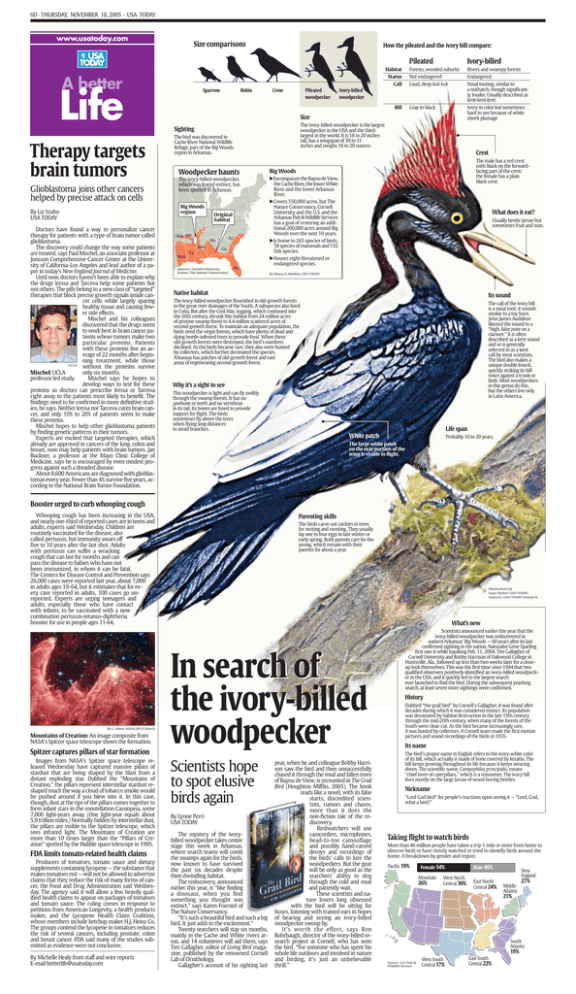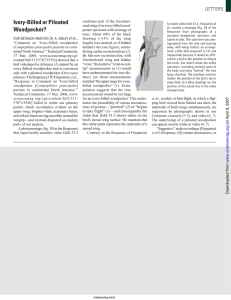A better
advertisement

6D · THURSDAY, NOVEMBER 10, 2005 · USA TODAY www.usatoday.com Size comparisons How the pileated and the ivory bill compare: Habitat Status Call A better Sparrow Robin Crow Pileated woodpecker Pileated Ivory-billed Forests, wooded suburbs Not endangered Loud, deep kuk kuk Rivers and swampy forests Endangered Nasal tooting, similar to a nuthatch, though significantly louder. Usually described as kent-kent-kent. Ivory in color but sometimes hard to see because of white cheek plumage Ivory-billed woodpecker Bill Gray to black Size The ivory-billed woodpecker is the largest woodpecker in the USA and the thirdlargest in the world. It is 18 to 20 inches tall, has a wingspan of 30 to 31 inches and weighs 16 to 20 ounces. Sighting Therapy targets brain tumors Glioblastoma joins other cancers helped by precise attack on cells The bird was discovered in Cache River National Wildlife Refuge, part of the Big Woods region in Arkansas. Woodpecker haunts Big Woods The ivory-billed woodpecker, which was feared extinct, has been spotted in Arkansas. vEncompasses the Bayou de View, the Cache River, the lower White River and the lower Arkansas River. vCovers 550,000 acres, but The Nature Conservancy, Cornell University and the U.S. and the Arkansas Fish & Wildlife Services has a goal of restoring an additional 200,000 acres around Big Woods over the next 10 years. vIs home to 265 species of birds, 58 species of mammals and 132 fish species. vHouses eight threatened or endangered species. Big Woods region By Liz Szabo USA TODAY Doctors have found a way to personalize cancer therapy for patients with a type of brain tumor called glioblastoma. The discovery could change the way some patients are treated, says Paul Mischel, an associate professor at Jonsson Comprehensive Cancer Center at the University of California-Los Angeles and lead author of a paper in today’s New England Journal of Medicine. Until now, doctors haven’t been able to explain why the drugs Iressa and Tarceva help some patients but not others. The pills belong to a new class of “targeted” therapies that block precise growth signals inside cancer cells while largely sparing healthy tissue and causing fewer side effects. Mischel and his colleagues discovered that the drugs seem to work best in brain cancer patients whose tumors make two particular proteins. Patients with these proteins live an average of 22 months after beginning treatment, while those UCLA without the proteins survive Mischel: UCLA only six months. professor led study. Mischel says he hopes to develop ways to test for these proteins so doctors can prescribe Iressa or Tarceva right away to the patients most likely to benefit. The findings need to be confirmed in more definitive studies, he says. Neither Iressa nor Tarceva cures brain cancer, and only 10% to 20% of patients seem to make these proteins. Mischel hopes to help other glioblastoma patients by finding genetic patterns in their tumors. Experts are excited that targeted therapies, which already are approved in cancers of the lung, colon and breast, now may help patients with brain tumors. Jan Buckner, a professor at the Mayo Clinic College of Medicine, says he is encouraged by even modest progress against such a dreaded disease. About 8,600 Americans are diagnosed with glioblastomas every year. Fewer than 4% survive five years, according to the National Brain Tumor Foundation. Crest Original habitat Okla. Ark. S.C. Ala. Miss. La. Ga. Texas Sources: Cornell University, Science, The Nature Conservancy Fla. The male has a red crest with black on the forwardfacing part of the crest; the female has a plain black crest. What does it eat? Usually beetle larvae but sometimes fruit and nuts. By Marcy E. Mullins, USA TODAY Native habitat Its sound The ivory-billed woodpecker flourished in old-growth forests in the great river drainages of the South. A subspecies also lived in Cuba. But after the Civil War, logging, which continued into the 20th century, shrunk this habitat from 24 million acres of pristine swamp forest to 4.4 million scattered acres of second-growth forest. To maintain an adequate population, the birds need the virgin forests, which have plenty of dead and dying beetle-infested trees to provide food. When these old-growth forests were destroyed, the bird’s numbers declined. As the birds became rare, they also were hunted by collectors, which further decimated the species. Arkansas has patches of old-growth forest and vast areas of regenerating second-growth forest. The call of the ivory bill is a nasal toot; it sounds similar to a toy horn. John James Audubon likened the sound to a “high, false note on a clarinet.” It is often described as a kent sound and so is generally referred to as a kent call by most scientists. The bird also makes a unique double knock, quickly striking its bill twice against a trunk or limb. Most woodpeckers in this genus do this, but the others live only in Latin America. Why it’s a sight to see This woodpecker is light and can fly swiftly through the swamp forests. It has no jawbone or teeth and no vertebrae in its tail. Its bones are fused to provide support for flight. The birds sometimes fly above the trees when flying long distances to avoid branches. Life span White patch Probably 10 to 20 years. The large white patch on the rear portion of the wing is visible in flight. Booster urged to curb whooping cough Whooping cough has been increasing in the USA, and nearly one-third of reported cases are in teens and adults, experts said Wednesday. Children are routinely vaccinated for the disease, also called pertussis, but immunity wears off five to 10 years after the last shot. Adults with pertussis can suffer a wracking cough that can last for months and can pass the disease to babies who have not been immunized, in whom it can be fatal. The Centers for Disease Control and Prevention says 26,000 cases were reported last year, about 7,000 in adults ages 19-64, but it estimates that for every case reported in adults, 100 cases go unreported. Experts are urging teenagers and adults, especially those who have contact with infants, to be vaccinated with a new combination pertussis-tetanus-diphtheria booster for use in people ages 11-64. By L. Allen, NASA/JPL/Caltech Mountains of Creation: An image composite from NASA’s Spitzer space telescope shows the formation. Spitzer captures pillars of star formation Images from NASA’s Spitzer space telescope released Wednesday have captured massive pillars of stardust that are being shaped by the blast from a distant exploding star. Dubbed the “Mountains of Creation,” the pillars represent interstellar stardust reshaped much the way a cloud of tobacco smoke would be pushed around if you blew into it. In this case, though, dust at the tips of the pillars comes together to form infant stars in the constellation Cassiopeia, some 7,000 light-years away. (One light-year equals about 5.9 trillion miles.) Normally hidden by interstellar dust, the pillars are visible to the Spitzer telescope, which sees infrared light. The Mountains of Creation are more than 10 times larger than the “Pillars of Creation” spotted by the Hubble space telescope in 1995. FDA limits tomato-related health claims Producers of tomatoes, tomato sauce and dietary supplements containing lycopene — the substance that makes tomatoes red — will not be allowed to advertise claims that they reduce the risk of many forms of cancer, the Food and Drug Administration said Wednesday. The agency said it will allow a few heavily qualified health claims to appear on packages of tomatoes and tomato sauce. The ruling comes in response to petitions from American Longevity, a health products maker, and the Lycopene Health Claim Coalition, whose members include ketchup maker H.J. Heinz Co. The groups contend the lycopene in tomatoes reduces the risk of several cancers, including prostate, colon and breast cancer. FDA said many of the studies submitted as evidence were not conclusive. By Michelle Healy from staff and wire reports E-mail betterlife@usatoday.com Parenting skills The birds carve out cavities in trees for nesting and roosting. They usually lay one to four eggs in late winter or early spring. Both parents care for the young, which remain with their parents for about a year. Illustration by Suzy Parker, USA TODAY Sources: USA TODAY research What’s new In search of the ivory-billed woodpecker Scientists hope to spot elusive birds again By Lynne Perri USA TODAY The mystery of the ivorybilled woodpecker takes center stage this week in Arkansas, where search teams will comb the swamps again for the birds, now known to have survived the past six decades despite their dwindling habitat. The rediscovery, announced earlier this year, is “like finding a dinosaur, when you find something you thought was extinct,” says Karen Foerstel of The Nature Conservancy. “It’s such a beautiful bird and such a big bird. It just adds to the excitement.” Twenty searchers will stay six months, mainly in the Cache and White rivers areas, and 14 volunteers will aid them, says Tim Gallagher, editor of Living Bird magazine, published by the renowned Cornell Lab of Ornithology. Gallagher’s account of his sighting last year, when he and colleague Bobby Harrison saw the bird and then unsuccessfully chased it through the mud and fallen trees of Bayou de View, is recounted in The Grail Bird (Houghton Mifflin, 2005). The book reads like a novel, with its false starts, discredited scientists, rumors and chases, more than it does the non-fiction tale of the rediscovery. Birdwatchers will use camcorders, microphones, head-to-toe camouflage and possibly hand-carved decoys and recordings of the birds’ calls to lure the woodpeckers. But the gear will be only as good as the searchers’ ability to slog through the cold and mud and patiently wait. These scientists and nature lovers long obsessed with the bird will be sitting for hours, listening with trained ears in hopes of hearing and seeing an ivory-billed woodpecker swoop by. It’s worth the effort, says Ron Rohrbaugh, director of the ivory-billed research project at Cornell, who has seen the bird. “For someone who has spent his whole life outdoors and involved in nature and birding, it’s just an unbelievable thrill.” Scientists announced earlier this year that the ivory-billed woodpecker was rediscovered in eastern Arkansas’ Big Woods — 60 years after its last confirmed sighting in the nation. Naturalist Gene Sparling first saw it while kayaking Feb. 11, 2004. Tim Gallagher of Cornell University and Bobby Harrison of Oakwood College in Huntsville, Ala., followed up less than two weeks later for a closeup look themselves. This was the first time since 1944 that two qualified observers positively identified an ivory-billed woodpecker in the USA, and it quickly led to the largest search ever launched to find the bird. During the subsequent yearlong search, at least seven more sightings were confirmed. History Dubbed “the grail bird” by Cornell’s Gallagher, it was found after decades during which it was considered extinct. Its population was devastated by habitat destruction in the late 19th century through the mid-20th century, when many of the forests of the South were clear-cut. As the bird became increasingly rare, it was hunted by collectors. A Cornell team made the first motion pictures and sound recordings of the birds in 1935. Its name The bird’s proper name in English refers to the ivory-white color of its bill, which actually is made of bone covered by keratin. The bill keeps growing throughout its life because it keeps wearing down. The scientific name, Campephilus principalis, means “chief lover of caterpillars,” which is a misnomer. The ivory bill lives mostly on the large larvae of wood-boring beetles. Nickname “Lord God bird” for people’s reactions upon seeing it — “Lord, God, what a bird!” Taking flight to watch birds More than 46 million people have taken a trip 1 mile or more from home to observe birds or have closely watched or tried to identify birds around the home. A breakdown by gender and region: Pacific 19% Female 54% Mountain 26% West North Central 30% Male 46% East North Central 24% New England Middle Atlantic 27% 21% South Atlantic 19% Source: U.S. Fish & Wildlife Service West South Central 17% East South Central 22%





